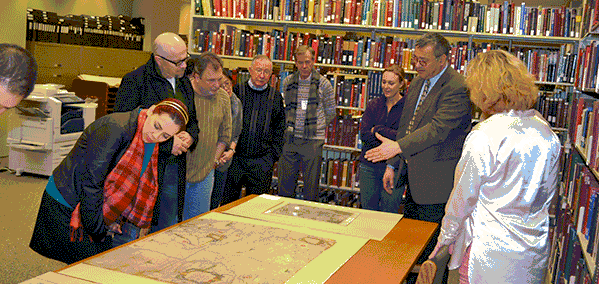Teaching & Learning

The AHA's broad-based teaching mission includes making resources available to educators at all levels and at public history venues, introducing and integrating historians into the discipline, providing ongoing education for historians at every stage of their careers—through topical and professional sessions at the annual meeting, and by way of both innovative web resources and distinguished print publications.
Historians are equally concerned with learning—their own ongoing research and other activities that expand their mission to bring history into public life. The AHA provides resources to historians in all fields and career paths, and advocates for the profession as a whole.
2016 Tuning Core Document
The Tuning Project's History Discipline Core is a statement of the central habits of mind, skills, and understanding that students achieve when they major in history. The document reflects the iterative nature of the tuning process. The most recent version was published in November 2016.
Teaching Resources
The American Historical Association has a long-standing commitment to teaching and history education at all levels, and supports teaching in a wide variety of ways. The AHA has developed resources for classroom teaching through the years, and the AHA Teaching Division is actively working on advancing conversations about teaching history. Find resources for use in your own teaching in our new Teaching Resources section, recently redesigned for greater easy of use.
AHA Teaching Prizes
Nominate someone today!
The Eugene Asher Award for distinguished postsecondary history teaching
The Beveridge Family Teaching Prize for distinguished K-12 history teaching
The William and Edwyna Gilbert Award for outstanding contributions to the teaching of history through the publication of journal articles
The Nancy Lyman Roelker Mentorship Award for teachers of history who taught, guided, and inspired their students in a way that changed their lives
AHA Online Teacher Institute in World History

To commemorate the 10th anniversary of its involvement in the creation of the C3 Framework, the AHA will convene a weeklong professional development institute via Zoom for K-12 teachers of world history (including dual-enrollment courses). The five sessions in this week-long program will explore how teachers can channel one of the most pressing questions in global current events to engage students in the world history classroom. Participants will join five two-hour sessions in Zoom over five days between July 31 and August 4.
Online Teaching Resources

As institutions transitioned to online instruction in the face of COVID-19, many historians were faced with the challenge of what it means to teach history online. The AHA developed resources to assist historians and teachers with online teaching, many of which can also be used for developing in-person courses. From assessing assignments, to supporting your faculty and students, to promoting student engagement, the AHA is here to help.
The Decision to Secede and Establish the Confederacy: A Selection of Primary Sources
The American Historical Association encourages continued public debate about monuments to Confederate leaders and about the public spaces and buildings named after those individuals, as well as the role of Confederate flags in public culture. Historians’ recent experiences in media interviews have suggested that too few participants in these conversations have read the essential primary sources that clearly articulate the reasons for secession and the establishment of a new nation. This page links to a limited set of documents with a singular focus: why did state governments decide to secede and form a new nation?
Future of the African American Past

On May 19-21, 2016, the AHA and the National Museum of African American History and Culture co-hosted The Future of the African American Past. The conference was held at the National Museum of the American Indian and the National Museum of American History. More than 60 scholars gathered together to celebrate the upcoming opening of the NMAAHC and consider the future of the study of African American history. All sessions were recorded, and noted historians blogged on the sessions in the following days. Participants tweeted to #FutureAAPast.
History Gateways Resources
The AHA has compiled a list of resources for faculty interested in the History Gateways initiative, including recommended readings on teaching introductory history courses, audiovisual resources, and webinar recordings available to AHA members.
.jpg)
Teaching and Learning Video Resources
Teaching is an essential skill for any historian, and the AHA works hard to produce resources for those teaching at all career stages and at all levels of history. Our Teaching and Learning video library includes workshops on K-12 and undergraduate teaching, reflections from historians on globalizing their US survey courses, and sessions on issues of vital importance to history education such as learning outcomes, dual enrollment, and the transition from high school to college.
A New Guide for Teaching in Civics, Economics, Geography, and History
 In collaboration with over 20 states and 15 social studies content organizations, including the AHA, the National Council for the Social Studies (NCSS) has released a guide to help states strengthen their social studies standards. The "College Career, and Civic Life (C3) Framework for Social Studies" encourages states to upgrade their social studies standards by offering robust guidelines to promote inquiry-based learning in civics, economics, geography, and history. AHA members and staff, joined by representatives of the Teaching Division, worked closely with the NCSS, state representatives, educators, and scholars to ensure that the standards demonstrate best practices in the discipline of history.
In collaboration with over 20 states and 15 social studies content organizations, including the AHA, the National Council for the Social Studies (NCSS) has released a guide to help states strengthen their social studies standards. The "College Career, and Civic Life (C3) Framework for Social Studies" encourages states to upgrade their social studies standards by offering robust guidelines to promote inquiry-based learning in civics, economics, geography, and history. AHA members and staff, joined by representatives of the Teaching Division, worked closely with the NCSS, state representatives, educators, and scholars to ensure that the standards demonstrate best practices in the discipline of history.
